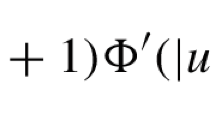Abstract
In a smoothly bounded domain \(\Omega \subset \mathbb {R}^n\), \(n\ge 1\), the quasilinear Keller–Segel system

is considered under homogeneous no-flux boundary conditions. It is firstly shown that if D and S, besides belonging to \(C^2([0,\infty ))\) with \(S(0)=0\), merely satisfy

then for all \(K>0\) there exists \(\varepsilon _\star (K)\in (0,\frac{R}{2})\) such that whenever \(0\le u_0\in W^{1,\infty }(\Omega )\) and \(0\le v_0\in W^{1,\infty }(\Omega )\) satisfy

a corresponding initial value problem for (\(\star \)) admits a global bounded classical solution with \((u,v)|_{t=0}=(u_0,v_0)\). Secondly, a more restrictive condition on the initial data, inter alia requiring appropriate smallness of both \(\Vert u_0\Vert _{L^\infty (\Omega )}\) and \(\Vert v_0\Vert _{W^{1,\infty }(\Omega )}\), is identified as sufficient to ensure exponential stabilization of the correspondingly obtained solution toward the equilibrium \((\frac{1}{|\Omega |} \int _\Omega u_0, \frac{1}{|\Omega |}\int _\Omega u_0)\). As a technical ingredient of crucial importance for the derivation of explicit pointwise bounds for the respective first solution components, the analysis relies on a refinement of a Moser-type iterative argument which, formulated here in a general context of parabolic inequalities, provides some quantitative information about the dependence of \(L^\infty \) estimates on bounds on the initial data and \(L^1\) bounds.
Similar content being viewed by others
References
Cao, X.: Global bounded solutions of the higher-dimensional Keller–Segel system under smallness conditions in optimal spaces. Discrete Contin. Dyn. Syst. Ser. A 35, 1891–1904 (2015)
Cieślak, T., Stinner, C.: Finite-time blowup and global-in-time unbounded solutions to a parabolic-parabolic quasilinear Keller–Segel system in higher dimensions. J. Differ. Equ. 252(10), 5832–5851 (2012)
Cieślak, T., Stinner, C.: New critical exponents in a fully parabolic quasilinear Keller–Segel system and applications to volume filling models. J. Differ. Equ. 258(6), 2080–2113 (2015)
Cieślak, T., Winkler, M.: Global bounded solutions in a two-dimensional quasilinear Keller–Segel system with exponentially decaying diffusivity and subcritical sensitivity. Nonlinear Anal. Real World Appl. 35, 1–19 (2017)
Cieślak, T., Winkler, M.: Stabilization in a higher-dimensional quasilinear Keller–Segel system with exponentially decaying diffusivity and subcritical sensitivity. Nonlinear Anal. 159, 129–144 (2017)
Ding, M., Zhao, X.: \({L}^\sigma \)-measure criteria for boundedness in a quasilinear parabolic-parabolic Keller–Segel system with supercritical sensitivity. Discrete Contin. Dyn. Syst. Ser. B 24, 5297–5315 (2019)
Herrero, M., Velázquez, J.: A blow-up mechanism for a chemotaxis model. Ann. Scuola Norm. Sup. Pisa Cl. Sci. 24(4), 633–683 (1997)
Hillen, T., Painter, K.J.: A user’s guide to PDE models for chemotaxis. J. Math. Biol. 58, 183–217 (2009)
Horstmann, D., Winkler, M.: Boundedness vs. blow-up in a chemotaxis system. J. Differ. Equ. 215, 52–107 (2005)
Ishida, S., Seki, K., Yokota, T.: Boundedness in quasilinear Keller–Segel systems of parabolic–parabolic type on non-convex bounded domains. J. Differ. Equ. 256, 2993–3010 (2014)
Lankeit, J.: Locally bounded global solutions to a chemotaxis consumption model with singular sensitivity and nonlinear diffusion. J. Differ. Equ. 262, 4052–4084 (2017)
Ladyzenskaja, O.A., Solonnikov, V.A., Ural’ceva, N.N.: Linear and Quasi-Linear Equations of Parabolic Type. Am. Math. Soc. Transl., vol. 23, Providence, RI (1968)
Nagai, T., Senba, T., Yoshida, K.: Application of the Trudinger–Moser inequality to a parabolic system of chemotaxis. Funkcial. Ekvac. 40, 411–433 (1997)
Osaki, K., Yagi, A.: Finite dimensional attractor for one-dimensional Keller–Segel equations. Funkcial. Ekvac. 44, 441–469 (2001)
Painter, K.J., Hillen, T.: Volume-filling and quorum-sensing in models for chemosensitive movement. Can. Appl. Math. Q. 10, 501–543 (2002)
Porzio, M., Vespri, V.: Holder estimates for local solutions of some doubly nonlinear degenerate parabolic equations. J. Differ. Equ. 103, 146–178 (1993)
Senba, T., Suzuki, T.: A quasi-linear parabolic system of chemotaxis. Abstr. Appl. Anal. Art. ID 23061 (2006)
Tao, Y., Winkler, M.: Boundedness in a quasilinear parabolic-parabolic Keller–Segel system with subcritical sensitivity. J. Differ. Equ. 252, 692–715 (2012)
Wang, Z.A., Winkler, M., Wrzosek, D.: Global regularity vs. infinite-time singularity formation in a chemotaxis model with volume filling effect and degenerate diffusion. SIAM J. Math. Anal. 44, 3502–3525 (2012)
Wang, Z.A., Winkler, M., Wrzosek, D.: Singularity formation in chemotaxis systems with volume-filling effect. Nonlinearity 24, 3279–3297 (2011)
Winkler, M.: Does a ‘volume-filling effect’ always prevent chemotactic collapse? Math. Methods Appl. Sci. 33, 12–24 (2010)
Winkler, M.: Finite-time blow-up in the higher-dimensional parabolic–parabolic Keller–Segel system. J. Math. Pures Appl. 100, 748–767 (2013)
Winkler, M.: Global existence and slow grow-up in a quasilinear Keller–Segel system with exponentially decaying diffusivity. Nonlinearity 30, 735–764 (2017)
Winkler, M.: Global classical solvability and generic infinite-time blow-up in quasilinear Keller–Segel systems with bounded sensitivities. J. Differ. Equ. 266, 8034–8066 (2019)
Winkler, M.: A unifying approach toward boundedness in Keller–Segel type cross-diffusion systems via conditional \(L^\infty \) estimates for taxis gradients. Preprint
Wrzosek, D.: Volume filling effect in modelling chemotaxis. Math. Model. Nat. Phenom. 5, 123–147 (2010)
Wrzosek, D.: Model of chemotaxis with threshold density and singular diffusion. Nonlinear Anal. 73, 338–349 (2010)
Acknowledgements
The second author acknowledges support of the Deutsche Forschungsgemeinschaft in the context of the project Emergence of structures and advantages in cross-diffusion systems (Project No. 411007140, GZ: WI 3707/5-1).
Author information
Authors and Affiliations
Corresponding author
Additional information
Publisher's Note
Springer Nature remains neutral with regard to jurisdictional claims in published maps and institutional affiliations.
Rights and permissions
About this article
Cite this article
Ding, M., Winkler, M. Small-density solutions in Keller–Segel systems involving rapidly decaying diffusivities. Nonlinear Differ. Equ. Appl. 28, 47 (2021). https://doi.org/10.1007/s00030-021-00709-4
Received:
Accepted:
Published:
DOI: https://doi.org/10.1007/s00030-021-00709-4



